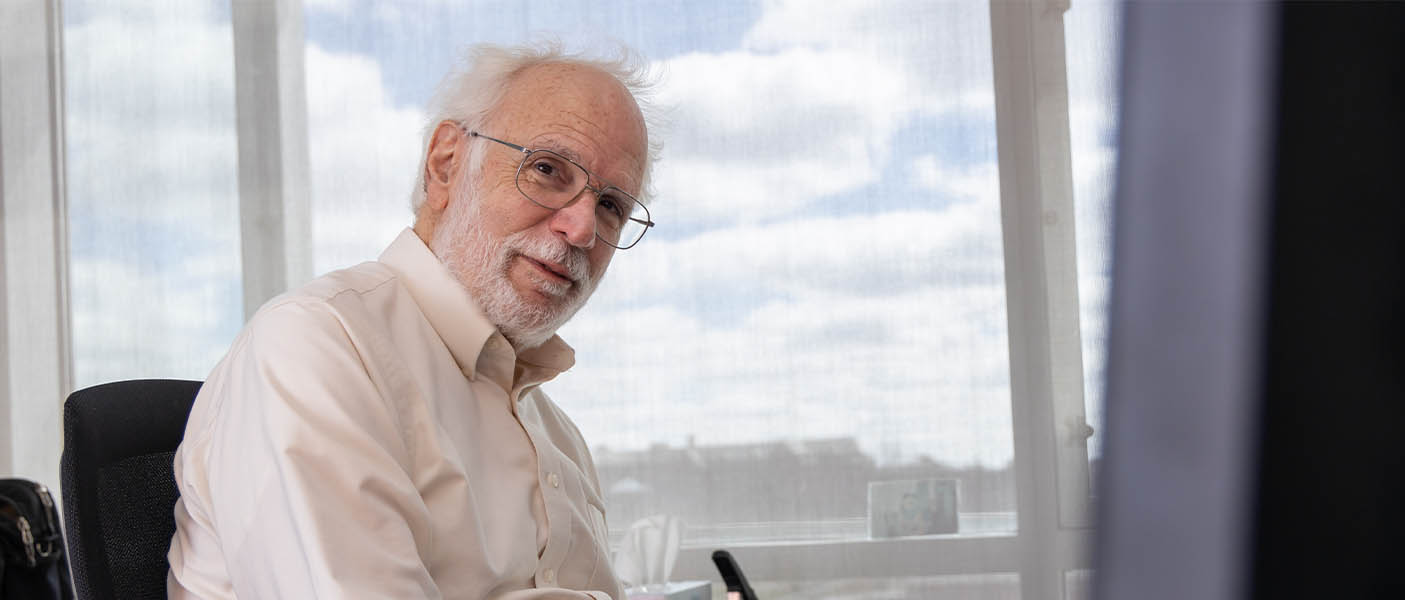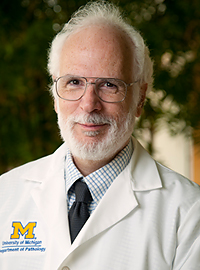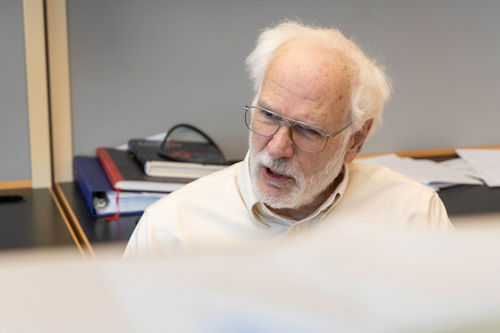

What do flying pigs, Yoda, and Oink have in common? No, not some cartoon pig, but our very own Dr. Richard Miller, Professor of Pathology and Director of the Paul Glenn Center for the Biology of Aging Research at the University of Michigan. Miller recently sat down with our communications team to discuss his research and give us insights into his perspectives on the research process. (We will learn more about his connections to flying pigs, Yoda, and Oink in a moment.)
 Miller grew up in the suburbs of Philadelphia and graduated from Haverford College prior to pursuing an MD/PhD degree at Yale, followed by postdoctoral work at Harvard and Sloan Kettering. He then worked as an Assistant and Associate Professor at Boston University for 8 years before relocating to the University of Michigan along with his wife, Patricia Yaeger, who was offered a tenured professorship position at UM in 1990. Miller was excited about the move as he had heard about Michigan’s strengths in aging research and had been interested in moving here. He and Patsy eagerly arrived in Ann Arbor and found Michigan to be a very good fit for them both. Miller jokes that he may be the only Professor of Pathology in the United States to have never successfully completed a course in pathology. He did take a pathology course at Yale, but since there were no exams, he can’t claim to have successfully completed it. “So, I am not a real-life pathologist.” He is a research scientist.
Miller grew up in the suburbs of Philadelphia and graduated from Haverford College prior to pursuing an MD/PhD degree at Yale, followed by postdoctoral work at Harvard and Sloan Kettering. He then worked as an Assistant and Associate Professor at Boston University for 8 years before relocating to the University of Michigan along with his wife, Patricia Yaeger, who was offered a tenured professorship position at UM in 1990. Miller was excited about the move as he had heard about Michigan’s strengths in aging research and had been interested in moving here. He and Patsy eagerly arrived in Ann Arbor and found Michigan to be a very good fit for them both. Miller jokes that he may be the only Professor of Pathology in the United States to have never successfully completed a course in pathology. He did take a pathology course at Yale, but since there were no exams, he can’t claim to have successfully completed it. “So, I am not a real-life pathologist.” He is a research scientist.
Miller knew from childhood that he wanted to pursue aging research because “aging is very bad for you. It makes you sick and then you die, and I am against that.” He wanted to find ways to slow the aging process. When he began his research as a graduate student, there were studies published at the time that suggested that cells got old in culture. He decided to find out how they did that. “The more I learned, the more I realized that was a mistake. Cells did not get old in culture…studying the idea that cells got old in culture was a waste of time and I didn’t want to do that anymore.” As a postdoctoral fellow, he decided to focus on immunology. “I thought if I learned how aging damaged or impaired the immune system, I would get general information on how aging damages other systems.” He spent 18 years focused on immune-related research in aging. “By that time, it had become clear that you could actually slow aging in mice. You can slow it with any of at least three different mutations and at least two different kinds of diet. Since you can slow aging, it seems logical that you can ask the somewhat obvious simple question, ‘How do these genes and diets slow aging?’”
With aging comes a cluster of health issues such as susceptibility to broken bones, cataracts, hearing loss, cancer, diabetes, Alzheimer’s, and many other conditions. “It all happens together in 2-year-old mice, 5-year-old dogs, 20-year-old horses, and 70-80-year-old people. Everyone knows that, but too few people are asking why it all happens together and why it only takes a couple years in mice and 70-80 years in people.” This has been Miller’s focus for the last 22 years. In his lab, he has explored the differences between long-lived and short-lived birds, rodents, and primates. He then considers what changes in physiology and cell biology distinguish cells from long-lived and short-lived species and generates ideas for drugs that can do the same things in mice and, perhaps, in people. In mice, genetic mutations can slow aging by 35-40%, the best drugs can extend lifespan by 24-30% and diets can extend lifespan by 30-40%. As a point of reference, Miller compared this to research published in Science in 1990 where demographers showed that if people never got cancer, they would on average gain only 2.6 extra years of life, or about 3%. In contrast, the drugs used in mice are 7 times better. “If these drugs work in people, which we don’t know yet, an average 91-year-old would be about as healthy as the average 70-year-old is today,” Miller explained.
Unfortunately, moving to a human clinical trial is cost- and time-prohibitive. “If you have a drug that slows aging, the right thing to do is take 30,000 50-year-olds and put half on the drug and half on placebo, then come back in 30 years and see who is alive, who is dead, who is sick and who is healthy. The reason this will never happen is the drug companies don’t want to invest hundreds of millions, or billions, of dollars into a 30-year trial that may not work.” Since this kind of trial is required for FDA approval, moving these drugs from mice to people is a challenge. However, some of the drugs may have other benefits that don’t take as long to prove, such as slowing Alzheimer’s, treating cancer, and reducing strokes, diabetes, or heart attacks. “If a trial could be conducted on healthy adults, then come back in 5-10 years and see the impact for common diseases, that might work well. I’m an enthusiastic supporter of this trial being conducted, even though it would be a $50 million endeavor,” stated Miller.
When asked about the cause of aging, Miller replied, “The key point is to recognize that this is the wrong question. The right question, one that few people think to ask is, what slows the aging process?” He went on to explain that people age quite slowly compared to mice, dogs and horses. The “bad stuff” doesn’t tend to happen in people for 50 years vs the 1-, 5-, and 20-years in mice, dogs, and horses respectively. Why? The Interventions Testing Program of the National Institute on Aging gave Miller and two other labs $1 million/year each to choose 5-7 drugs annually and test them on mice to determine the impact to healthy lifespans and to uncover the shared mechanisms/pathways that lead to extended life. With this knowledge, researchers may be able to discover commonalities that lead to extended life in other species, including people.
Dr. Samuel “Joe” Endicott, a Research Investigator in the Miller lab and a member of the division of Experimental Pathology, is studying the process of "chaperone mediated autophagy," CMA. CMA is generally only turned on when mice have been fasting, but in slow-aging mutant mice, this pathway is always on. “This is a hint that drugs that cause CMA to go up in normal mice may be a good thing. Joe has a couple he is testing to see if they may be associated with slowed aging across many different experimental systems,” said Miller. Another member of his lab, Dr. Xinna Li, Assistant Research Scientist in Experimental Pathology, is pursuing a different mechanism. She is studying a protein produced by the liver, GPLD1, which becomes elevated when people exercise. Another lab discovered that mice with elevated levels of GPLD1 continue to create new brain cells even beyond the age when brain cells typically stop being made. Li discovered that GPLD1 is turned on by all three of the anti-aging mutations being studied in the lab as well as by five of the drugs being studied. “It looks like this could be a common factor connecting anti-aging genes with anti-aging drugs and exercise to improve cognition and to improve maintenance of brain cell health. This would be really cool!” enthused Miller. Dr. Gonzalo Garcia is another extremely productive member of the Miller lab. “He is working on selective translation of messenger RNAs and he has made excellent progress as well.”
 The greatest challenges of being a successful research scientist are “having good people coming into the lab, convincing reviewers that our research is terrific and they should either publish it or give us a grant, getting money to do the work, and coming up with good ideas. Out of 20 ideas, you may be lucky to find 2-4 of them that will turn out to be good ideas…if you are really, really lucky,” explained Miller. “Finding an idea that deserves a $1 million investment and can justify asking a graduate student or post-doc to spend 3 years of work on the project, is a difficult skill, and no one is really terrifically good at it.” However, a couple times per year, he does have the thrill of someone coming into his lab and excitedly saying, “Hey! Look at this. This is really interesting…I got these new data and I didn’t expect to see that. I wonder what it means?”
The greatest challenges of being a successful research scientist are “having good people coming into the lab, convincing reviewers that our research is terrific and they should either publish it or give us a grant, getting money to do the work, and coming up with good ideas. Out of 20 ideas, you may be lucky to find 2-4 of them that will turn out to be good ideas…if you are really, really lucky,” explained Miller. “Finding an idea that deserves a $1 million investment and can justify asking a graduate student or post-doc to spend 3 years of work on the project, is a difficult skill, and no one is really terrifically good at it.” However, a couple times per year, he does have the thrill of someone coming into his lab and excitedly saying, “Hey! Look at this. This is really interesting…I got these new data and I didn’t expect to see that. I wonder what it means?”
Miller then discussed his mentors and their impact on him. In particular, he discussed the impact made by his high school chemistry teacher, Dr. Walter Stamper. Though he was earning an “A” in the class, Miller didn’t feel like he understood the principles and went to ask Stamper what to do about his frustrating sense of confusion. Stamper told him, “Every good scientist will understand that they really don’t know what they are doing most of the time. You hang in there and in 2-3 years, you will know. You will look back and all of this will have fallen into line. Just be patient with yourself.” This is a lesson that he carries with him to this day and tries to instill in those he mentors in his own laboratory. Miller explained, “If a student reads an article in a new area and understands 5%, once they have read 10 articles, they may go back to the first one and understand 27%. That is a real win. You need to have the kind of personality that doesn’t find it hopelessly frustrating to be confused most of the time.” Miller is fond of Niels Bohr's maxim: "An expert is someone who has made all the mistakes which can be made, in a narrow field."
When asked for some fun facts about himself, he facetiously replied, “I am 417th in the line of succession to the throne of Romania. That is not technically true, but I would like to see that in the article so if anyone does a Google search for ‘throne of Romania’ and ‘aging research’, my name would appear at the top of the results list.” Miller’s sense of humor leads us to flying pigs, Yoda, and Oink, as promised earlier in the article. He related a story about a well-known scientist who has been trying to convince people that he has the cure for aging. In rebuttal to an article published about this scientist in the MIT alumni magazine, Miller wrote a parody on how to develop scientific techniques to convert pigs into flying pigs. This was printed in the MIT alumni magazine, then picked up and reprinted by GQ Magazine! Yoda was a mouse from his lab that had the distinction of being the world’s oldest mouse at about 4 years of age. Mice in the wild tend to live an average of 6 months, whereas in the lab, they average about 2.5 years of age. Yoda’s story was published by UM, picked up by 127 publications and appeared on the cover of USA Today. It then made its way to the producers of Oink, a British TV show for preschoolers and kindergartners who have an interest in science. “To make this work in the British time zone, I had to get up at 2:00 AM for a radio conversation with the listeners of Oink. I hope at least a few British kindergartners had their career trajectory changed by this broadcast,” mused Miller.
For more information on Miller and his laboratory’s work, visit his lab website here.